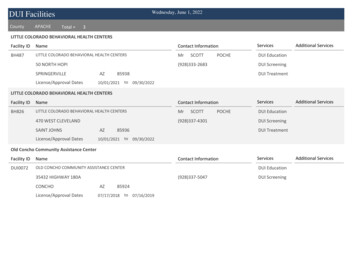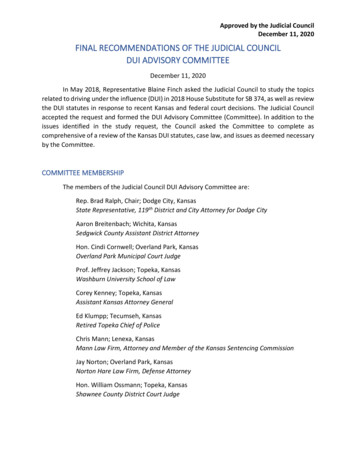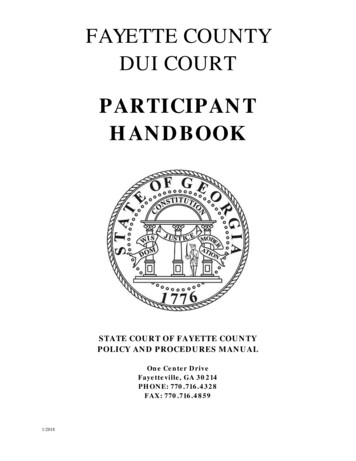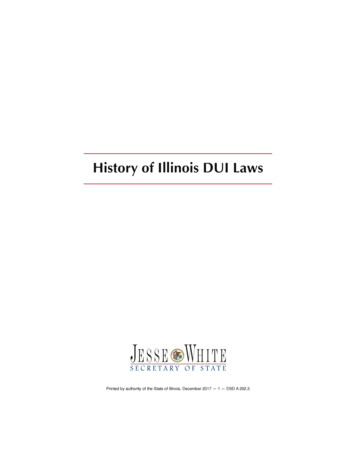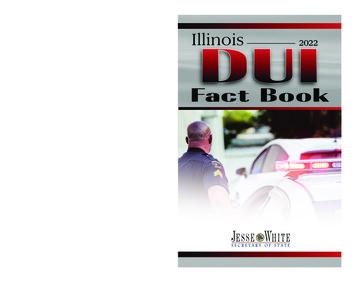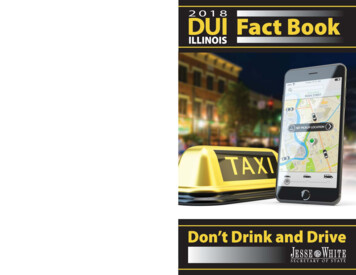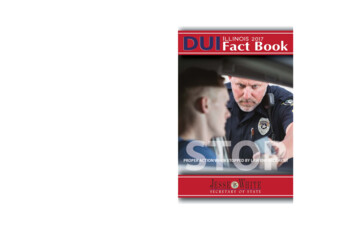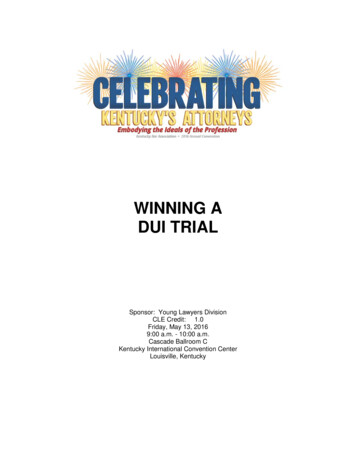
Transcription
WINNING ADUI TRIALSponsor: Young Lawyers DivisionCLE Credit: 1.0Friday, May 13, 20169:00 a.m. - 10:00 a.m.Cascade Ballroom CKentucky International Convention CenterLouisville, Kentucky
A NOTE CONCERNING THE PROGRAM MATERIALSThe materials included in this Kentucky Bar Association Continuing LegalEducation handbook are intended to provide current and accurate information about thesubject matter covered. No representation or warranty is made concerning theapplication of the legal or other principles discussed by the instructors to any specificfact situation, nor is any prediction made concerning how any particular judge or jury willinterpret or apply such principles. The proper interpretation or application of theprinciples discussed is a matter for the considered judgment of the individual legalpractitioner. The faculty and staff of this Kentucky Bar Association CLE programdisclaim liability therefore. Attorneys using these materials, or information otherwiseconveyed during the program, in dealing with a specific legal matter have a duty toresearch original and current sources of authority.Printed by: Evolution Creative Solutions7107 Shona DriveCincinnati, Ohio 45237Kentucky Bar Association
TABLE OF CONTENTSThe Presenter . iDriving Under the Influence LawHow to Successfully Defend a Driving Under the Influence Case . 1Important Cases . 1Theory and Themes. 5Discovery – The Key to Success . 5Ways around the Blood Alcohol Number . 7Voir Dire . 11Cross Examination. 192,100 to 1 Breath to Blood Ratio . 33
THE PRESENTERWilbur M. ZevelyBusald Funk Zevely, PSC226 Main StreetPost Office Box 6910Florence, Kentucky 41022-6910(859) 371-3600wzevely@aol.comWILBUR M. ZEVELY is a partner in the law firm Busald Funk Zevely, PSC. He haspracticed law since 1972 and concentrates his practice in the areas of criminal law,domestic relations and DUI cases. Mr. Zevely received his B.S. degree from theUniversity of Cincinnati and his J.D. from Salmon P. Chase School of Law. Prior toentering the practice of law, he worked as a chemist for The Monsanto Company, undercontract with the United States Atomic Energy Commission.In the early 1970s Mr. Zevely incorporated and ran "The 15th Judicial District PublicDefender, Inc." which was the first state funded public defender program in the NorthernKentucky area. The program represented indigent clients in Boone, Gallatin, Grant,Carroll and Owen counties.Mr. Zevely is a frequent speaker on DUI issues for the Kentucky Association of CriminalDefense Lawyers, the Kentucky Bar Association, the Northern Kentucky Bar Associationand the Kentucky Department of Public Advocacy. He also writes a regular column onDUI tips for the Kentucky Association of Criminal Defense newsletter. In addition, Mr.Zevely co-authors the Kentucky Driving Under the Influence law book. The book isrewritten annually and has been in publication for nineteen years.He is a member of the Kentucky and Ohio Bar Associations, the National Association ofCriminal Defense Lawyers and the Kentucky Association of Criminal Defense Lawyers,for which he has served as director since its formation. Mr. Zevely is admitted topractice in Federal Court for the Southern District of Ohio and the Eastern District ofKentucky.He was the recipient of the Northern Kentucky Bar Association's 2014 DistinguishedLawyer Award, as well as their 2015 Lifetime Achievement Award.i
ii
DRIVING UNDER THE INFLUENCE LAWHOW TO SUCCESSFULLY DEFEND A DRIVING UNDER THE INFLUENCE CASEWil M. ZevelyI.IMPORTANT CASESA.Adams v. Commonwealth, 275 S.W.3d 209 (Ky. App. 2008). This casedefines what is meant by motor vehicle. The case holds that a vehicle isa means of transporting persons or property. If it has a motor, it is amotor vehicle.B.Ballinger v. Commonwealth, 459 S.W.3d 349 (Ky. 2015). This caseoverruled Commonwealth v. Beard, 275 S.W.3d 205 (Ky. App. 2008).Ballinger had a prior DUI conviction. Thereafter, he received two moreDUI charges. While the latter two were pending, he received another DUIcharge. The last DUI charge was listed as a second. Thereafter, heplead guilty to the middle two DUIs. The last DUI, which was charged asa second, was indicted as a fourth offense by the grand jury. TheKentucky Supreme Court held, on DUI cases, because of the statute,Kentucky is NOT a conviction to offense date state for enhancementpurposes. The court must look at prior convictions at plea date todetermine any appropriate enhancements. At conviction, Ballinger hadthree prior convictions.C.Elery v. Commonwealth, 368 S.W.3d 78 (Ky. 2012). This case seems tosuggest the limitation on the admissibility of a PBT is on theCommonwealth and not the defense. PBT numbers that are favorable tothe defendant may be admissible under this case.D.Rogers v. Commonwealth, 315 S.W.3d 303 (Ky. 2010). As stated by theCourt in this case, "As differentiated from defining reasonable doubt, wehave more recently held that attempts to show what reasonable doubt isnot do not violate the rule against defining reasonable doubt."E.Commonwealth v. Davis, 25 S.W.3d 106 (Ky. 2000), abrogated byCommonwealth v. Carman, 455 S.W.3d 916 (Ky. 2015) (prosecutioncannot initiate a request for the Supreme Court to certify a law.) Thiscase involved a Campbell County Intoxilyzer. The machine had a numberof out of tolerances over a number of different time periods. All the timeperiods were close in time to the date of the defendant's test. On the dayof the test, there were no out of tolerances and the machine had acalibration check within the requirements. The Supreme Court held that ifthe machine was working properly on the day of the test, the results wereadmissible even though the machine did not work properly at other times.The problems with the machine went to the weight, not the admissibility ofthe result. The machine is working properly if the testing unit and thecalibration unit are in proper working order on the day of the test. Thetesting unit (the Intoxilyzer) is in proper working order if the accuracy ofthe machine is established before and after the subject test.1
F.Commonwealth v. House, 295 S.W.3d 825 (Ky. 2009). This is a DUIcase where a subpoena duces tecum under R.Cr. 7.02(3) was issued toCMI, the manufacturer of the Intoxilyzer 5000 EN. The subpoenarequired the production of the computer's source codes. The sourcecodes are the programs the computer uses to interpret data obtained inanalyzing the defendant's breath sample. The Commonwealth and CMIobjected to the subpoena and moved to quash. During the hearing, thedefendant put on a computer software engineer who testified that if thesource codes for the instrument were produced, he could examine thecodes for any "bugs" or "flaws" in the code's logic which may becontained therein and which, as a result, MAY produce an inaccurateblood alcohol reading. The expert did not testify he knew of any errors orflaws or had any knowledge of any defects in the machine. The SupremeCourt reversed the Court of Appeals and disallowed the issuance of thesubpoena. The Court relied, in part, on U.S. v. Nixon, 418 U.S. 683(1974). That case held four part tests would be used in determiningwhether or not a defendant is entitled to production of the subpoenaedmaterial prior to trial. The moving party must show:1.The documents are evidentiary and relevant;2.That they are not otherwise producible reasonably in advance oftrial by exercising due diligence;3.That the party cannot properly prepare for trial without suchproduction and inspection in advance of trial;4.That failure to obtain such inspection may tend unreasonably todelay the trial; and,5.That the application is made in good faith and is not intended as ageneral fishing expedition.The Supreme Court held that a subpoena is unreasonable if the partydemanding the production can point to nothing more than hope orconjecture that the subpoenaed material will produce admissible results.The Court stated the subpoena was nothing more than a classic fishingexpedition. This issue is not dead. It is well-known that the mouth alcoholsafety aspect of the Intoxilyzer is defective. The Intoxilyzer is alsosusceptible to interference from other volatile organic compounds. Thesecould include acetone, paint vapors, cleaning fluids, or other similarorganic compounds. These issues were not before the Court. It wouldbe much easier to show that the source codes are flawed, as theycertainly are, as the codes pertain to these areas of the machine.G.Commonwealth v. Lamberson, 304 S.W.3d 72 (Ky. App. 2010). In thisDUI case, the attorney for the defendant pled him guilty to DUI in hisabsence. The written paperwork that was produced at the plea showed aknowing, voluntary, and intelligent plea and waiver of his constitutionalrights. This was the standard DUI guilty plea form. There was not,however, a written waiver of the defendant's right to be present under2
R.Cr. 8.28(4). The Court held that the conviction was defective; however,the Court went on to say that if prior DUIs are going to be attacked underBoykin issues, the attack must be done at the first opportunity. In thiscase, the defendant had been convicted with an enhanced penalty usingthe defective DUI plea in a subsequent case. The prior DUI had not beenattacked in that case. The Court held his right to attack the prior DUI waswaived as he had not attacked it at the first opportunity.H.Commonwealth v. Long, 118 S.W.3d 178 (Ky. App. 2003). This case setforth standards required by the police in reference to the rights of thedefendant in obtaining his own test after taking all of the requested testsby the Commonwealth. The case basically holds that the cop must usereasonable efforts to allow the defendant to obtain his test. The effects ofthis case under the new Drug Driving Bill may present a problem for theCommonwealth.I.Commonwealth v. Mattingly, 98 S.W.3d 865 (Ky. App. 2002). This caseinvolved a per se prosecution. Only the number was prosecuted. In thiscase, the Court would not allow any evidence in reference to field sobrietytest results or the number and timing of drinks. The Appellate Courtreversed, holding that this evidence is admissible as circumstantialevidence that the machine was not working correctly. Hence, someonewho does well on field sobriety testing may introduce the results to showthat the machine is wrong. Also, the number and timing of drinks may beintroduced for the same purpose.J.Ferguson v. Commonwealth, 362 S.W.3d 341 (Ky. App. 2011). This casedeals with the implied consent statute and a person's right to call alawyer. The defendant had her cell phone with her attorney's numberprogrammed in it. A jail policy precluded the use of cell phones. The copwould only allow the defendant to make a collect call and would not allowher to even use her cell phone to get the attorney's number. Theappellate court held the cop's conduct was not reasonable citing Long(supra). The cop should have allowed the defendant to retrieve the phonenumber and to call.K.Greene v. Commonwealth, 244 S.W.3d 128 (Ky. App. 2008). In this casethe defendant was charged as a fourth offense DUI. The case held thatthe PBT is inadmissible in any trial pursuant to KRS 189A.104 (2). Thecase went on to state that the PBT would be admissible, but only for thepurposes of showing probable cause. In that instance, the number is notadmissible, only the fact that the machine showed the presence ofalcohol.L.Hardin v. Commonwealth, 2007 WL 79055 (Ky. App. Jan. 12, 2007)(opinion ordered not to be published). Field sobriety testing, as it stands,is admissible under KRE 701, not KRE 702. The difference is lay opinionversus expert testimony. The National Highway Traffic SafetyAdministration (NHTSA) standard tests are not Daubert qualified. Apolice officer can only testify as to what he asked the defendant to do and3
what the defendant did. He cannot testify as to pass/fail, indicators, oranything to do with scientific aspects of these tests.M.Lopez v. Commonwealth, 173 S.W.3d 905 (Ky. 2005). This is Kentucky'slandmark decision on relation back. The case holds that the jury must beinstructed that to find guilt the defendant must be 0.08 or above at thetime of operation. The test must be administered, to be admissible in perse prosecutions, within two hours of operation. If this time period isstipulated, it need not be in the instructions. Do not let the prosecutionargue that all they have to do to prove guilt is to show that the test wasgiven within two hours and the defendant was a 0.08. Also, the caseholds no expert is needed to prove and argue relation back.N.Wells v. Commonwealth, 709 S.W.2d 847 (Ky. App. 1986). This isKentucky's landmark decision on what constitutes operation or physicalcontrol of a motor vehicle under the Kentucky DUI statute. The caseholds that factors to be considered are as follows:1.Whether or not the person in the vehicle was asleep or awake;2.Whether or not the motor was running;3.The location of the vehicle and the circumstances bearing on howthe motor vehicle arrived at that location;4.The intent of the person behind the wheel.O.Commonwealth v. Armstrong, 2013 WL 645979 (Ky. App. Feb. 22, 2013)(ordered not to be published). Passed out in lot at Fourth Street Live.Foot on accelerator, engine revving. Parked legally – doors locked. Onehand on wheel – other on shifter. Reviews and approves Wells v.Commonwealth, 709 S.W.2d 847 (Ky. App. 1986) – Starting vehicle notenough.P.Commonwealth v. Bedway, 466 S.W.3d 468 (Ky. 2015). "Reasonableaccommodations" must be made by arresting officer to allow accusedright to attempt to contact an attorney. Sets forth list of factors toconsider. (Calling daughter on cell at 5:45 a.m. to get attorneys phonenumber is allowed; cell phone phone book; a phone that allows collectcalls only is an impermissible limitation – suppressing BA proper –Ferguson v. Commonwealth, 362 S.W.3d 341 (Ky. App. 2011)).Automatic suppression of test results not appropriate remedy unlessofficer deliberately disregarded statute or accused suffered prejudice –Copley v. Commonwealth, 361 S.W. 3d 902 (Ky. 2012).Q.Missouri v. McNeely, 133 S.Ct. 1552 (2013), Natural dissipation of alcoholin blood is not an exigent circumstance in every case.R.Duncan v. Commonwealth, 2013WL3816017 (Ky. App. 2013). The plainlanguage of the implied consent law does not require arresting officer tooffer defendant a breath test before or instead of a blood test. Officer4
may request any test (breath, blood, or urine) in any order. This case isnot final and may not be cited as authority. The case relies in part onBeach v. Commonwealth, 927 S.W.2d 826 (Ky. 1996).II.III.THEORY AND THEMESA.How Can You Advance Your Theory of the Case?B.What Is Your Plan?1.What is your story of innocence?2.What is your theory of the case?DISCOVERY – THE KEY TO SUCCESSA.B.C.Avenues to Obtain Discovery1.Discovery by the rules.2.Statement of witnesses.3.Videos.4.Motions to Suppress.a.The stop – driving.b.The arrest – field sobriety tests.c.B.A.Motions to Suppress – Why?1.Learn about driving – stop.2.Learn about tests – p/c to arrest.3.Learn about BA – problems.4.A record for cross examination and impeachment.5.Under RCr 8.18 motion to suppress must be made pretrial.6.Under RCr 8.27(2) hearing must be before trial.Motions to Suppress1.Is the stop valid?a.Weaving.5
i.U.S. v. Freeman, 209 F.3d 464 (6th Cir. 2000).ii.U.S. v. Smith, 799 F.2d 704 (11th Cir. 1986).b.Statutory violation.c.Pre-textual stops are valid. d.Caretaker function. 2.3.4.5.Whren v. U.S., 517 U.S. 806 (1996)Poe v. Com, 169 S.W.3d 54 (Ky. App. 2005)Is the intrusion valid?a.What right to give field tests in minor traffic stops?b.State v. Dixon, 2000 WL 1760664 (Ohio App. 2000).c.State v. Taylor, 444 N.E.2d 481 (Ohio App. 1 Dist. 1981).d.Garcia v. Commonwealth, 185 S.W.3d 658 (Ky. App.2006).e.Adults different than 21.Is there probable cause to arrest?a.Field test.b.Speech.c.Driving.d.Smell of alcohol.What right to do the breathalyzer or blood?a.Reasonable grounds to believe DUI – 189A.103(3).b.Implied consent – probable cause.Suppress Breathalyzer.a.Operator at BA room twenty minutes – 189A.103. b.Personal observationOperator certified every two years – 189A.103.6
D.c.Follow administrative regulations – 500 KAR 8.d.Follow manufacturer's instructions – 189A.103.e.Test within two hours of operation.f.If BA machine is working the day of the test – test isadmissible – Commonwealth v. Davis, 25 S.W.3d 106 (Ky.2000), abrogated by Commonwealth v. Carman, 455S.W.3d 916 (Ky. 2015) (prosecution cannot initiate arequest for the Supreme Court to certify a law.)Simulator must work day of test.ii.Intoxilyzer must be accurate .005 on the day ofservice before and after test.Dealing with PBT1.Greene v. Com, 244 S.W.3d 128 (Ky. App. 2008).a.PBT not admissible at trial.b.PBT admissible for probable cause.c.PBT must be properly administered.d.Number not admissible.2.KRS 189A.104 – PBT not admissible.3.PBT may be admissible in trials not involving DUI. IV.i.Allen v. Com., 817 S.W.2d 458 (Ky. App. 1991)WAYS AROUND THE BLOOD ALCOHOL NUMBERA.Relation Back – Lopez v. Commonwealth, 173 S.W.3d 905 (Ky. 2005)B.BA Wrong1.Field tests good.2.Good driving.3.BA wrong – number of drinks unequal to test result.4.Machine errors from temperature, hematocrit and breathingpatterns.5.Interferent - Volatile organic solvents.7
a.Paint.b.Keytones.c.Cleaning fluids.d.Source code; Commonwealth v. House, 295 S.W.3d 825(Ky. 2009).C.Wreck with Airbag Deployment – Talcum Powder Affects BAD.Mouth Alcohol1.2.Substances and other things in mouth.a.Cavities.b.Plates.c.Chewing tobacco.d.Acid reflux.e.Burp or sick at stomach.Intoxilyzer will not fix this problem even though maker claims itwill. 3.Source code; Commonwealth v. House, 295 S.W.3d 825(Ky. 2009)The slope detector does not always detect the presence of mouthalcohol.a.The Champion March 2006.b.Journal of Forensic Sciences, Vol. 37 No.4, July 1992, pp.999-1007.8
Relationback Chart9
E.Discovery for Intoxilyzer (Instrument not in proper working order)1.Downloads.2.Maintenance records.3.Service records.4.Log book.5.History of machine.10
V.VOIR DIREA.B.Purposes of Voir Dire1.Learn.2.Educate – Relation back.3.Introduce your theory.4.Inspire jurors to care about your theory.5.Find jurors who can buy your story.6.Humanize client.7.Make jury step into client's shoes.8.Challenge for cause.Basic Thoughts1.Don't talk.2.Listen.3.Look for bad jurors.11
4.Don't look for good jurors.5.What do you want jurors to think about?6.How do you make jurors solve your problems?7.Theory of the case.What things exist that show sobriety?b.What is your story of innocence?c.How are you going to sell it?i.Is it relation back?ii.Is the machine not right?iii.Refusal?8.How can you advance your case with the cop?9.Plan your use of the cop10.C.a.a.Can you impeach him?b.Can you show he is a liar?c.Can he be your friend?d.The jury will judge your treatment of the cop.Voir dire.a.Must deal with cross on voir dire.b.Will people buy what you are selling?c.How do jurors feel about cops?Communication Style of the Storyteller1.Give up control to the juror.2.Take advantage of primacy and recency.3.No legalese or jargon.4.Use simple language.5.Do not lecture – Teach your theory.12
D.E.6.Do not try to change the juror's opinions.7.Be yourself.Yes & No Questions1.Allows you to talk to every juror.2.You must question each juror.3.Expand areas of questioning.4.Make every juror answer the question.5.Remember you learn nothing with yes/no questions.The Storyteller Uses Open Ended Questions1.An open ended question is one that cannot be answered yes orno.2.A closed ended question can only be answered yes or no.3.Good:4.a.How do you feel about . . .b.What do you think of . . .c.What does that mean to you d.Can you think of a reason . . .e.Why would someone . . .f.Why . . . .g.How . . .Bad:a.Can you . . .b.Could you . . .c.Would you . . .d.Will you . . .e.Promise me . . .f.Any problems with . . .13
F.G.H.I.Talk with Each Juror1.Do not concentrate on one or two jurors.2.Each juror must be questioned on your most important areas.3.This may be a problem with some judges.How Many Topics1.Remember primacy and recency.2.Focus on your theory of the case.3.Take out the sting. Deal with problems here, you can't deal withthem in the jury room.4.Problems:a.BA over limit.b.Bad driving.c.Bad field tests.d.Bad statements.e.Prior DUI convictions.The Scaled Question1.As Henry sits there, on a scale of 1 to 10, guilty – not guilty – howdo you see him?2.On a scale of 1 to 10, as to believability, how do you see theofficer?3.On a scale of 1 to 10, as to believability, how do you see Henry?Modified Scaled Question1.Strongly agree.2.Somewhat agree.3.Somewhat disagree.4.Strongly disagree.a.It is better to set nine guilty people free than it is to convictone innocent person.14
b.J.Beware of Qualified Answers1.K.What are they?a.Probably.b.I think so.c.Usually.d.Sometimes.e.I generally agree.2.Listen to what jurors say.3.Pay attention to jurors – not your questions.4.Always make eye contact.Demonstrative Evidence1.Can you use it in voir dire? L.If machine is properly serviced and appears to be workingproperly, you must believe the number.Parker v. Commonwealth, 241 S.W.3d 805 (Ky. 2007)2.It must be admissible.3.Show pictures – jurors need to be where your client was.Things to Talk About1.Drinkers & non-drinkers.a.How will non-drinkers look at a DUI trial?b.Can non-drinkers sit on a jury?c.Why don't they drink?d.If they did drink, why did they stop?e.Believe wrong to drink & drive – moral reason.f.Do you ride with people who have been drinking?g.How do you know if they are ok to drive?15
2.3.h.How much is enough?i.How does time factor into this?Relation back – Lopez v. Commonwealth, 173 S.W.3d 905 (Ky.2005).a.08 at driving.b.Have BA of .128 at 2:00 a.m.; driving at 1:00 a.m.c.Are they the same?d.How do you relate back?e.What is the fastest way to get something in blood?f.What is the slowest way?g.What happens to alcohol when you drink?h.How long does it take alcohol to get in the blood?i,.How long does it take alcohol to get out of the blood?Driving.a.Who has gone the wrong way down a one way street?b.Who has had a wreck?c.Who has been caught speeding?d.Drinking w/above.e.Why do people drive badly?f.i.Cell phone.ii.Smoking.iii.Talking.iv.Strange area.v.Sleepy.Does bad driving not equal DUI?16
4.5.Field testing.a.Taken.b.Seen.c.Why do people do poorly on these tests?i.Environment.ii.Rain.iii.Wind.iv.Road s.ix.Injury.x.Not coordinated/athletic vs. clumsy.xi.Other traffic.Intoxilyzer.a.Above .08 why shouldn't we just plead guilty?b.How do you do with your machines?c.What would you want to know about machine before youbelieve?i.Past performance.ii.Past mistakes.iii.Maintenance records.iv.What if broken before?v.What about age?vi.What about warranty?17
d.If the machine is properly serviced and appears to beworking properly, you must believe the number.e.Why wouldn't you believe the machine?f.What things may cause you to doubt machine?g.6.i.Good driving.ii.Good field tests.iii.Showing not impaired.What effect would something trapped in your mouth haveon machine?i.Taste it hours later.ii.What about dentures, plates, cavities?iii.What about paint or cleaning fluids/why do theykeep young kids away from it?h.If you took a drink and immediately blew into the machine,what would happen?i.How long must you wait before the alcohol is gone?j.If you took a drink and immediately took a blood test, whatwould it show?k.What if you burped?l.What if you have acid reflux?m.What if you are sick – have a fever?n.What effect if you have smoked for years?Refusal of Intoxilyzer.a.Do you have to take it?b.Would you take it if you knew it was broken?c.Would you take it if someone told you it was not reliable?d.If you had questions would you want to talk to someonewho knew?18
7.8.9.VI.Presumption of innocence.a.Assault on the attorney.b.How do you prove innocence?c.Have you heard of people being set free after being lockedup for years for a crime they didn't do?d.Why were they freed?e.Should someone not guilty have to prove their innocence?f.What is my job?Client testifying.a.If he doesn't testify, he must be guilty.b.Why wouldn't he testify?c.Why would I tell him not to?d.What would you tell client to do?e.What would be your considerations?Unanimous verdict.a.Do you have to agree on guilt or innocence?b.What if you can't agree?c.What if the split is 11 to 1, would you change your vote?d.Why would you change your vote?e.What do you do if you can't agree?f.Who runs your life – boss, wife, kids?g.What if you disagree – fight?CROSS EXAMINATIONA.You Are the Witness in Cross ExaminationB.Use the Cop to Show Indications of Sobriety19
C.D.Rules of Cross in DUI1.Make the cop your friend.2.Never repeat the direct.3.Never repeat bad facts.4.Review all good points – indications of sobriety – things yourcitizen did properly.5.Use the cop to advance your theory of the case.Mistakes Made in Cross1.Lack of preparation.a.Must get discovery.b.Motion practice – a way to win quick.c.E.i.Bad stop – driving doesn't violate law or showreasonable suspicion.ii.State v. Dixon motions – 2000 WL 1760664 (Courtof Appeals of Ohio, Second District, Green CountyDec. 1, 2000) (not reported in N.E.2d) – what rightto go beyond stop.iii.State v Chatton, 463 N.E.2d 1237 (Ohio 1984).iv.Field tests – no showing of probable cause toarrest.v.Reasonable suspicion DUI required to give BA;KRS 189A.103(1).Discovery and motions to suppress are the tools foreffective cross.2.Not asking leading questions.3.Not keeping total control of cop.4.Repeating prosecution case.5.Never ask open-ended questions.Good Starts v. Bad Starts1.Good starts.20
2.F.G.a.Use statements, not questions.b.Single fact statement.i.He was . . .ii.He wasn't . . .iii.He did . . .iv.He didn't . . .c.Cop can only answer "yes" or "no."d.Cop can never explain an answer.Bad starts.a.Would you explain?b.Why?c.Who?d.How?e.Any open-ended question.Areas to Review1.Good driving.2.Good stopping.3.Good things at initial contact.4.Good things about field tests.5.Things that can affect all of the above.6.Environment.7.Personal problems of client.Field Tests1.Are they admissible?2.What can prosecutor use?21
a.Hardin v. Com, 2007 WL 79055 (Ky. App. Jan. 12, 2007)(ordered not to be published). 701 lay witnesses vs. 702 expert witnessesb.Bridgers v. Com, 2007 WL 121846 (Ky. App. Jan. 19,2007) (not reported in S.W.3d).c.Unreported cases can be cited d.CR 76.28(4)(c)U.S. v. Horn, 185 F.Supp.2d 530 (2002).DUI: Phase III WAT & OLSSFSTsA tool to assist you in seeing visible signs of impairmentNot pass/fail tests OBJ6Remember the three SFSTs are all tools to assist you in seeingvisible signs of impairmentsThey are not pass/fail testsThe three SFSTs, along with the PBT, are all field sobriety tests.Their role in DUI detection is to help establish probable cause, aidin the arrest decision, and help you decide which evidential test youshould request.AFQH.Field Tests - Your Cross1.These tests are no longer pass/fail.2.Use manual.3.Review things done right – Absence of indicators.4.Use own scoring chart with things done right and wrong.5.May not have failed tests using manual – one clue no matter howmany times repeated.22
I.J.6.Review things cop did wrong – contrary to manual.7.Learn clues on all tests.General Concerns1.Be aware of what is happening during 3.Other traffic and flashing lights.4.Amount of traffic.5.Flashing lights and cars driving by with lights – HGN.6.Proximity of citizen or distractions.In Car Field Sobriety Tests1.Number count – twenty-eight to sixteen.2.Alphabet – D to Q.3.Finger count.23
Walk & Turn Test CluesInstruction Stage:B.S.Can't keep BalanceStarts too soonWalking Stage:SHORTSOBJ1LECStops WalkingFails to touch Heel to ToeSteps Off LineRaises ArmsTurns ImproperlyWrong Number of StepsWalk and Turn Clues:Instruction Stage:Can't keep BalanceStarts too soonWalking Stage:S Stops WalkingH Fails to touch Heel to ToeO Steps Off LineR Raises ArmsT Turns ImproperlyS Wrong Number of StepsNTFInform students that the acronym SHORTS will help them to learnthe eight clues possible in the W&T test.Have the students copy the information from the slide.24
QUALIFYING QUESTIONPrior to starting the balance tests ask:"Is there anything that would prevent you from taking abalance test?"OBJ3LECQualifying Question:Prior to starting the W&T the following question should be asked:"Is there anything that would prevent you from taking a balancetest?"Ask this question in this manner. Do not suggest an answer within thequestion, i.e., "There's no reason you can't take a balance test is there?"This would be a leading question.AFQTest Interpretation of CluesBoth balance tests – Even if a clue shows up more than once, each clueis counted only once.Instructions Stage: Can't Keep Balance – Record this clue if the suspect does not maintain the heel-to-toeposition throughout the instructions. The feet must actually break apart. Do not record th
the defective DUI plea in a subsequent case. The prior DUI had not been attacked in that case. The Court held his right to attack the prior DUI was waived as he had not attacked it at the first opportunity. H. Commonwealth v. Long, 118 S.W.3d 178 (Ky. App. 2003). This case set forth standards required by the police in reference to the rights of the
